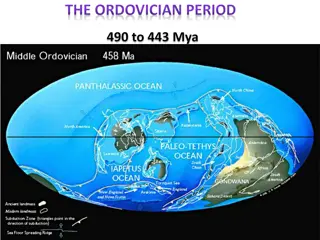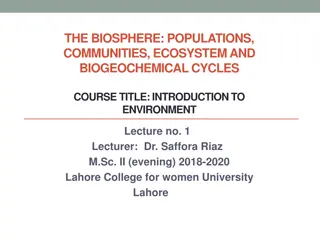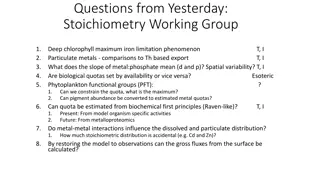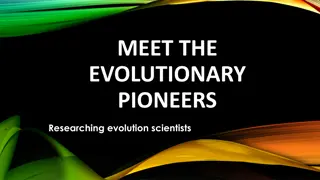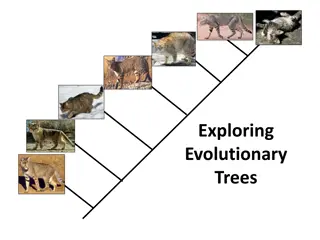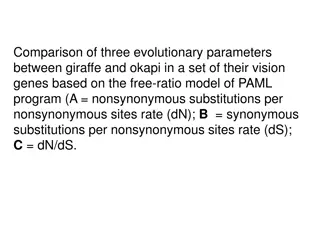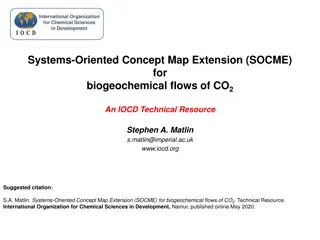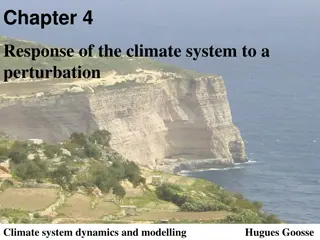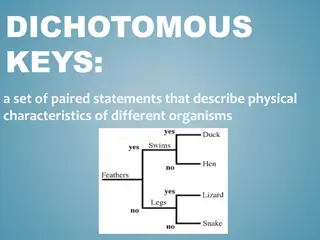Insights into Biogeochemical Cycles and Evolutionary History of Earth
The Earth's elemental composition has remained constant over its 4.5 billion-year history, with biogeochemical cycles playing a vital role in shaping the atmosphere and oceans. The evolution of oxygen, ozone, and life on Earth is intricately linked to these cycles. Contrasting Earth and Venus, it's evident how our planet avoided a runaway greenhouse effect. Understanding the oxidation states of nitrogen and examples of major biogeochemical processes provide insights into the complex interactions in the Earth system.
- Biogeochemical Cycles
- Evolutionary History
- Earths Atmosphere
- Nitrogen Oxidation
- Elemental Composition
Download Presentation

Please find below an Image/Link to download the presentation.
The content on the website is provided AS IS for your information and personal use only. It may not be sold, licensed, or shared on other websites without obtaining consent from the author. Download presentation by click this link. If you encounter any issues during the download, it is possible that the publisher has removed the file from their server.
E N D
Presentation Transcript
CHAPTER 6: BIOGEOCHEMICAL CYCLES THE EARTH: ASSEMBLAGE OF ATOMS OF THE 92 NATURAL ELEMENTS Most abundant elements: oxygen (in solid earth!), iron (core), silicon (mantle), hydrogen (oceans), nitrogen, carbon, sulfur The elemental composition of the Earth has remained essentially unchanged over its 4.5 Gyr history Extraterrestrial inputs (e.g., from meteorites, cometary material) have been relatively unimportant Escape to space has been restricted by gravity Biogeochemical cycling of these elements between the different reservoirs of the Earth system determines the composition of the Earth s atmosphere and oceans, and the evolution of life
HISTORY OF EARTHS ATMOSPHERE N2 CO2 H2O O2 O2 reaches current levels; life invades continents oceans form CO2 dissolves [head] forest Life forms in oceans Onset of photosynthesis Outgassing 4.5 Gy B.P 4 Gy B.P. 0.4 Gy B.P. 3.5 Gy B.P. present
Evolution of oxygen and ozone over Earths history Life appears on land
RUNAWAY GREENHOUSE EFFECT ON VENUS due to accumulation of water vapor from volcanic outgassing early in its history did not happen on Earth because farther from Sun; as water accumulated it reached saturation and precipitated, forming the oceans EARTH VENUS
Comparing the atmospheres of Earth and Venus Venus Earth Radius (km) 6100 6400 Surface pressure (atm) 91 1 CO2 (mol/mol) 0.96 3x10-4 N2 (mol/mol) 3.4x10-2 0.78 O2 (mol/mol) 6.9x10-5 0.21 H2O (mol/mol) 3x10-3 1x10-2
BIOGEOCHEMICAL CYCLING OF ELEMENTS: examples of major processes Physical exchange, redox chemistry, biochemistry are involved Surface reservoirs
OXIDATION STATES OF NITROGEN N has 5 electrons in valence shell 9 oxidation states from 3 to +5 Increasing oxidation number (nitrogen is oxidized) -3 0 +1 +2 +3 +4 +5 NH3 Ammonia NH4+ Ammonium R1N(R2)R3 Organic N N2 Dinitrogen N2O Nitrous oxide NO Nitric oxide HONO Nitrous acid NO2- Nitrite NO2 Nitrogen dioxide HNO3 Nitric acid NO3- Nitrate Decreasing oxidation number (nitrogen is reduced)
THE NITROGEN CYCLE: MAJOR PROCESSES combustion lightning ATMOSPHERE N2 NO oxidation HNO3 denitri- fication forest biofixation deposition orgN decay NH3/NH4+ NO3- BIOSPHERE assimilation nitrification weathering burial LITHOSPHERE
BOX MODEL OF THE NITROGEN CYCLE Inventories in Tg N Flows in Tg N yr-1
Ammonia formation by Haber-Bosch process (1909) high T, p metal catalyst N2 + 3H2 2NH3 enabled 20th century population growth through fertilizer production Fritz Haber Carl Bosch
Global human perturbation to nitrogen cycle Global anthropogenic N fixation now exceeds natural: 8 160 J.N. Galloway, UVa Nr Creation, Tg N/yr Population, billions Atmosphere 6 120 Natural 4 80 2 40 NH3 NO 40 30 Tg N a-1 0 0 1850 1900 1950 2000 2050 fossil fuel C-BNF agricultural biofixation Population Haber Bosch Fossil Fuel Resulting N deposition (NH4+, NO3-) modifies ecosystem function, C storage Annual N deposition critical load Zhang et al. [2012]
N2O: LOW-YIELD PRODUCT OF BACTERIAL NITRIFICATION AND DENITRIFICATION Important as source of NOx radicals in stratosphere greenhouse gas Main anthropogenic source: agriculture IPCC [2014]
FAST OXYGEN CYCLE: ATMOSPHERE-BIOSPHERE Source of O2: photosynthesis nCO2 + nH2O (CH2O)n + nO2 Sink: respiration/decay (CH2O)n + nO2 nCO2 + nH2O O2 lifetime: 6000 years CO2 1.2 106 Pg O Net photosynthesis by green plants: 200 Pg O/yr O2 forest orgC decay orgC litter
but abundance of organic carbon in biosphere/soil/ocean reservoirs is too small to control atmospheric O2 levels
SLOW OXYGEN CYCLE: ATMOSPHERE-LITHOSPHERE O2 lifetime: 3 million years O2: 1.2x106 Pg O CO2 O2 Photosynthesis decay runoff Fe2O3 H2SO4 weathering CO2 O2 orgC FeS2 OCEAN CONTINENT orgC Uplift burial CO2 orgC: 1x107 Pg C FeS2: 5x106 Pg S microbes FeS2 orgC SEDIMENTS Compression subduction










